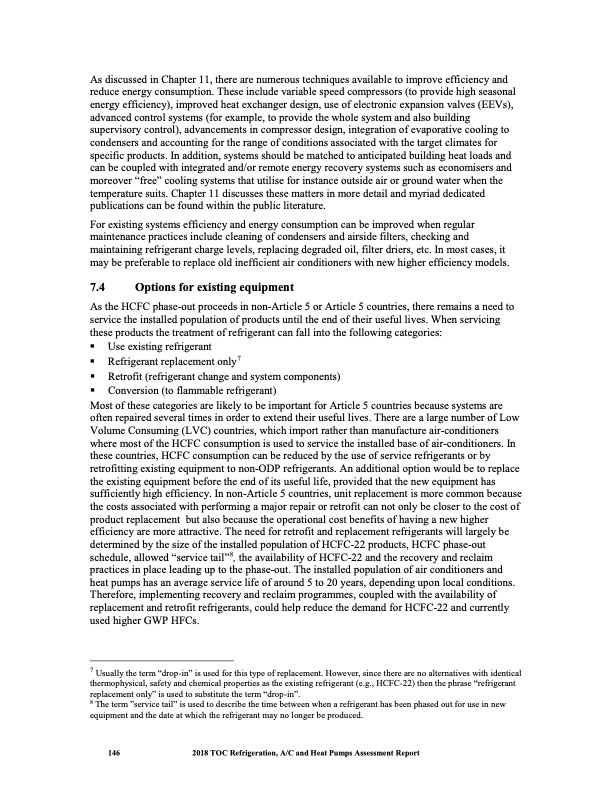
PDF Publication Title:
Text from PDF Page: 159
As discussed in Chapter 11, there are numerous techniques available to improve efficiency and reduce energy consumption. These include variable speed compressors (to provide high seasonal energy efficiency), improved heat exchanger design, use of electronic expansion valves (EEVs), advanced control systems (for example, to provide the whole system and also building supervisory control), advancements in compressor design, integration of evaporative cooling to condensers and accounting for the range of conditions associated with the target climates for specific products. In addition, systems should be matched to anticipated building heat loads and can be coupled with integrated and/or remote energy recovery systems such as economisers and moreover “free” cooling systems that utilise for instance outside air or ground water when the temperature suits. Chapter 11 discusses these matters in more detail and myriad dedicated publications can be found within the public literature. For existing systems efficiency and energy consumption can be improved when regular maintenance practices include cleaning of condensers and airside filters, checking and maintaining refrigerant charge levels, replacing degraded oil, filter driers, etc. In most cases, it may be preferable to replace old inefficient air conditioners with new higher efficiency models. 7.4 Options for existing equipment As the HCFC phase-out proceeds in non-Article 5 or Article 5 countries, there remains a need to service the installed population of products until the end of their useful lives. When servicing these products the treatment of refrigerant can fall into the following categories: Use existing refrigerant Refrigerant replacement only7 Retrofit (refrigerant change and system components) Conversion (to flammable refrigerant) Most of these categories are likely to be important for Article 5 countries because systems are often repaired several times in order to extend their useful lives. There are a large number of Low Volume Consuming (LVC) countries, which import rather than manufacture air-conditioners where most of the HCFC consumption is used to service the installed base of air-conditioners. In these countries, HCFC consumption can be reduced by the use of service refrigerants or by retrofitting existing equipment to non-ODP refrigerants. An additional option would be to replace the existing equipment before the end of its useful life, provided that the new equipment has sufficiently high efficiency. In non-Article 5 countries, unit replacement is more common because the costs associated with performing a major repair or retrofit can not only be closer to the cost of product replacement but also because the operational cost benefits of having a new higher efficiency are more attractive. The need for retrofit and replacement refrigerants will largely be determined by the size of the installed population of HCFC-22 products, HCFC phase-out schedule, allowed “service tail”8, the availability of HCFC-22 and the recovery and reclaim practices in place leading up to the phase-out. The installed population of air conditioners and heat pumps has an average service life of around 5 to 20 years, depending upon local conditions. Therefore, implementing recovery and reclaim programmes, coupled with the availability of replacement and retrofit refrigerants, could help reduce the demand for HCFC-22 and currently used higher GWP HFCs. 7 Usually the term “drop-in” is used for this type of replacement. However, since there are no alternatives with identical thermophysical, safety and chemical properties as the existing refrigerant (e.g., HCFC-22) then the phrase “refrigerant replacement only” is used to substitute the term “drop-in”. 8 The term ”service tail” is used to describe the time between when a refrigerant has been phased out for use in new equipment and the date at which the refrigerant may no longer be produced. 146 2018 TOC Refrigeration, A/C and Heat Pumps Assessment ReportPDF Image | Heat Pumps Technical Options

PDF Search Title:
Heat Pumps Technical OptionsOriginal File Name Searched:
RTOC-assessment-report-2018_0.pdfDIY PDF Search: Google It | Yahoo | Bing
CO2 Organic Rankine Cycle Experimenter Platform The supercritical CO2 phase change system is both a heat pump and organic rankine cycle which can be used for those purposes and as a supercritical extractor for advanced subcritical and supercritical extraction technology. Uses include producing nanoparticles, precious metal CO2 extraction, lithium battery recycling, and other applications... More Info
Heat Pumps CO2 ORC Heat Pump System Platform More Info
| CONTACT TEL: 608-238-6001 Email: greg@infinityturbine.com | RSS | AMP |